- In this section
- Public information and communications
- Election officials and office staff
- Candidate nominations
- Voting
- Counting
- Notable events
- Orders
- Page Navigation
- PREVIOUS | NEXT
Public information and communications
For the 2017 Provincial General Election, Elections BC developed a comprehensive and integrated communications strategy to engage voters and other stakeholders in the electoral process.
In addition to messages about voter registration and election day, the campaign focused on the many voting opportunities available to voters in B.C. and the key message that voters can vote at any voting opportunity in the province. Elections BC took extra steps to reach youth, Aboriginal people, people with disabilities, new Canadians and others who are less likely to register and vote.
The strategy was built on research and data from the 2013 Provincial General Election, historical information, and information gathered through efforts. It encompassed a variety of activities, including:
- advertising in newspapers, on television, on radio, online and in public places (through posters in restaurants and bars and on public transit);
- conducting a comprehensive social and digital media campaign;
- mailing Where to Vote cards;
- providing an informational Voter’s Guide to the public through district electoral offices, partner organizations, and the Elections BC website;
- implementing a comprehensive media relations strategy;
- operating a 1-800 contact centre for voter inquiries; and
- implementing a strategic program.
Advertising
In accordance with the Election Act, Elections BC placed two statutory advertisements in newspapers across the province. The first notice included information about the candidate nomination process and the dates and hours for general and advance voting. The second provided information about candidates, when and where to vote, and voter identification requirements.
The general election public awareness campaign ran from April 12 to May 8, and continued the look and feel of the “I Register” enumeration campaign. The theme of the campaign was “I Vote”. Like the enumeration campaign, it featured Trevor Linden and a diverse group of individuals representing all British Columbians.
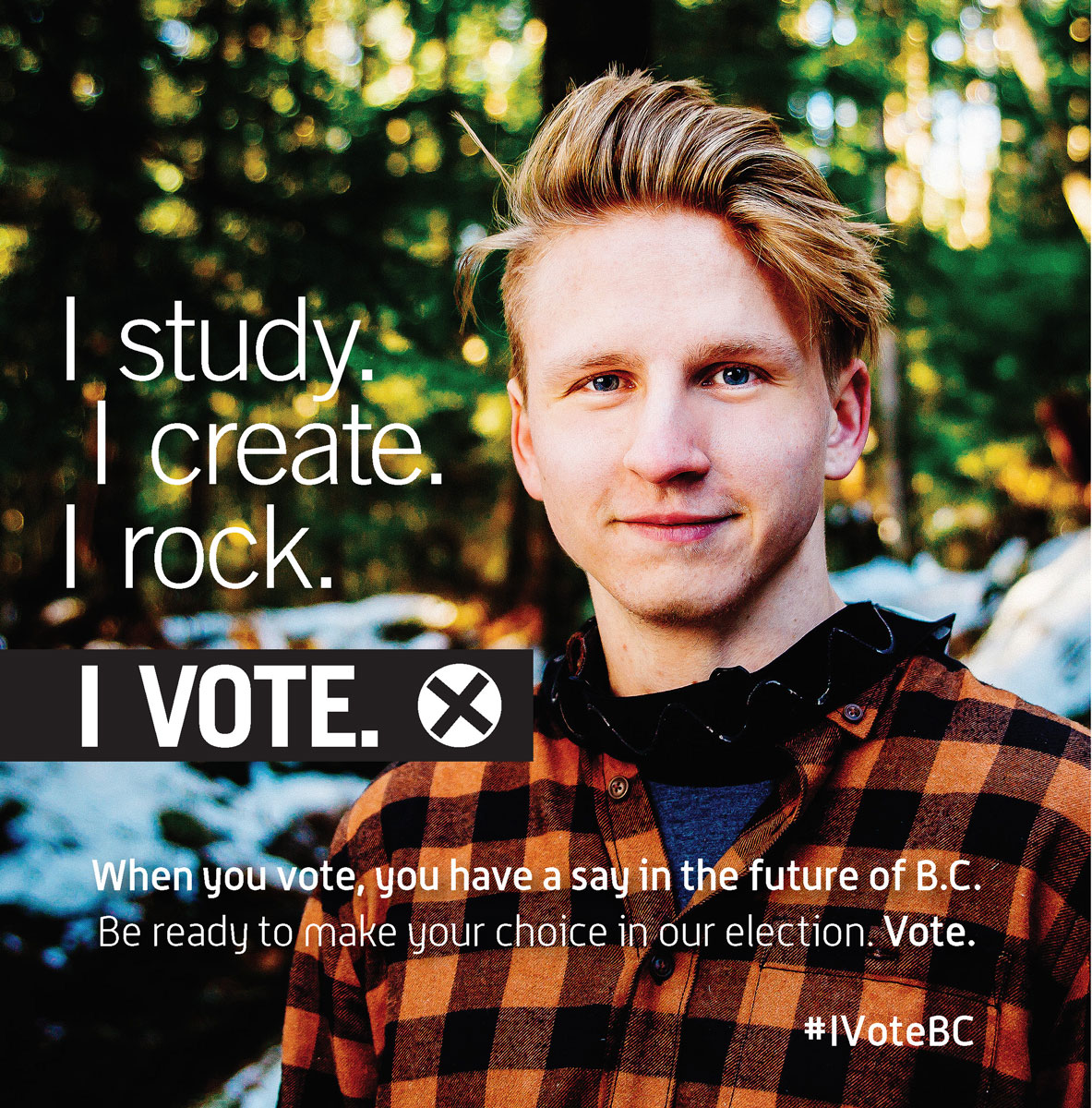
Website
In preparation for the 2017 Provincial General Election, the Elections BC website was relaunched on February 10, 2017 with a new design, updated content and enhanced support for mobile devices. The website continued to be a primary resource for voters, the media and other audiences seeking information about the election.
Website traffic was significantly higher for this election than in 2013. The website received 943,991 visits during the election period (an average of 33,714 per day), with 205,147 visits on General Voting Day. Forty-three percent of visitors to the Elections BC website accessed the site using mobile devices, an increase of 23% over 2013.
Website visits during the election period
|
2013 |
2017 |
|
|
Website visits during the election period |
435,335 |
943,991 |
|
Website visits on General Voting Day |
65,325 |
205,147 |
|
Percentage of visits from mobile devices |
20% |
43% |
A dedicated general election event page answered the most frequently asked questions from voters, and provided key event information (such as candidate lists and district electoral office contact information).
The Elections BC website also provided a Where to Vote application that allowed users to enter their address to find their assigned voting place. Users could also find voting places near them based on their location, and the application would provide directions. Voting places, as well as district electoral offices and electoral boundaries, were displayed on a Google Map.
On election night, results were reported online, starting when polls closed at 8 p.m. (Pacific time). Results were updated every three minutes as counting progressed, and were available by candidate or electoral district.

Social Media
During the election period, Elections BC’s social media channels supported the “I Vote” messaging of the larger public awareness campaign. Elections BC incorporated the existing hashtags #bcelxn17 and #bcelxn2017 into its social media posts. These hashtags, developed organically, were used by the majority of the general public and political participants engaging in the general election conversation on social media. Elections BC also promoted the hashtag #IVoteBC to encourage voter participation.
Elections BC incorporated #IVoteBC into the “selfie poster” project. For the first time in a provincial election in B.C., posters were available at voting places for voters to use as a background to take a voting day selfie. Voters could share their photos via social media with the campaign hashtag #IVoteBC. Posters were put up in each voting place in an area that did not affect privacy or impede the flow of people in and out of the voting place.
Building on the popularity of the “I Voted” stickers given to voters during the 2013 Provincial General Election, Elections BC created “First Time Voter” stickers for youth, new Canadians or anyone else who voted for the first time in 2017. “Future Voter” stickers were also given to children at voting places to encourage voters to bring their families. Voters sharing images of their “I Voted”, “First Time Voter” and “Future Voter” stickers was popular on social media.
Elections BC received a significant number of messages and questions via social media during both the enumeration and general election periods. The use of paid social posts helped increase voter engagement with Elections BC’s social media channels, since users did not have to be following Elections BC’s social accounts for a promoted post to appear in their newsfeed.
By responding to inquiries via social media, Elections BC was able to direct users to the relevant information on its website and answer questions quickly. Recognizing that many voters find social media more timely and accessible than contacting Elections BC by phone, staff endeavoured to answer questions received via social media promptly.
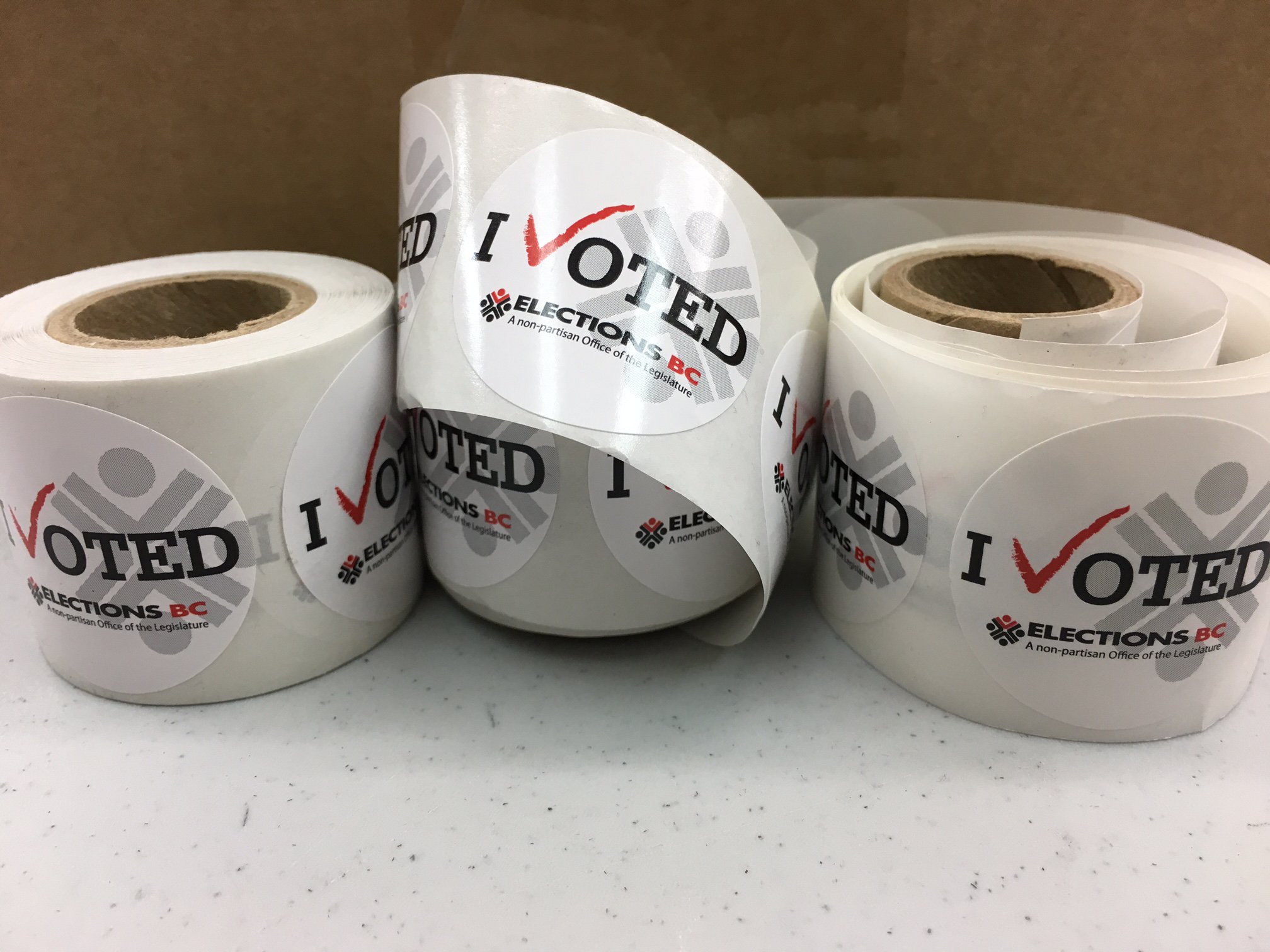
Elections BC’s social media audience continued to grow throughout the election period. Overall, Elections BC’s social channels grew by 98% through the enumeration and general election.
Elections BC also partnered with local sites Daily Hive Vancouver, Miss 604 and Vancouver is Awesome to access their existing audiences and to target youth. Together, these influencers reach over one million people.
Elections BC worked closely with each site to develop videos and articles tailored to their audience. Content was shared on social media by the publisher and Elections BC. Sponsored articles generated more than 22,000 page views, and videos were viewed more than 200,000 times.
Where to Vote card
As in previous years, the Where to Vote card remained a key feature of the general election public awareness campaign. To ensure voters were aware of the voting opportunities in their community, a Where to Vote card was mailed to every registered voter in B.C. ahead of the advance voting period. Each registered voter’s card showed the dates and locations for advance voting in their electoral district, the voter’s assigned general voting place, and information about eligibility requirements and acceptable voter identification. Over three million cards were sent to registered voters throughout B.C.
New for this election, Where to Vote cards were colour-coded by electoral district, enabling election officials to quickly determine if a voter was voting outside of their district (and should vote through the absentee voting process). Also new for this election, colourless “unaddressed cards” were mailed to addresses with no registered voters. These cards reached out to unregistered eligible voters with information about eligibility requirements, the option for voters to register when they vote, and voting opportunities.
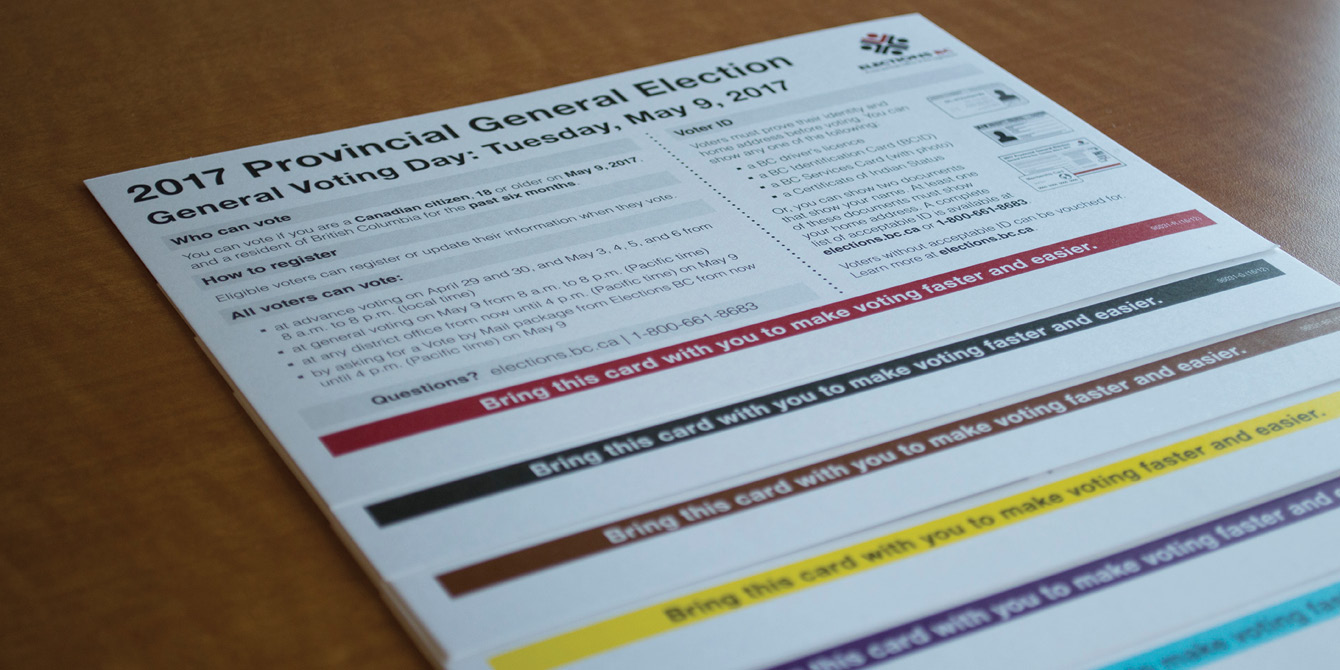
Voter’s Guide
Elections BC produced a Voter’s Guide containing information about voting dates and times, voter eligibility requirements, and acceptable voter identification. The Voter’s Guide also included basic information about the electoral process, a “what to expect when you vote” infographic, and a timeline of key dates in the election period.
The design of the Voter’s Guide matched the look and feel of the overall advertising campaign. Copies of the Voter’s Guide were available at district electoral offices and through partner organizations. Digital copies of the Voter’s Guide translated into 16 languages were available on the Elections BC website.
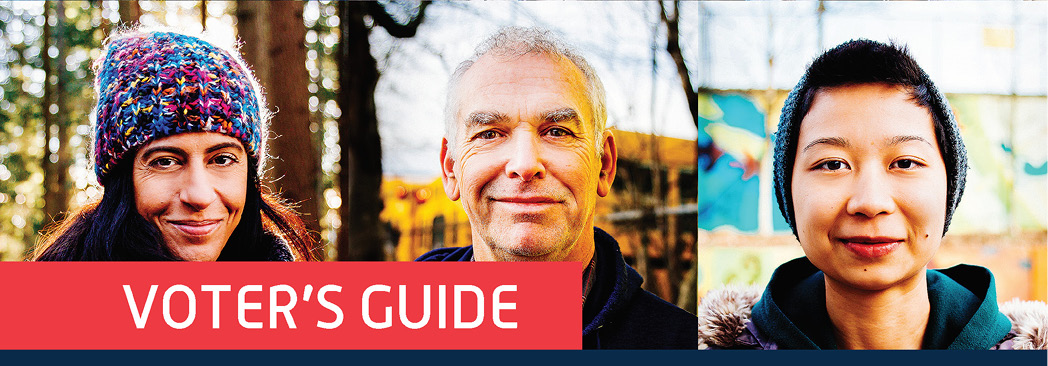

News releases and media advisories
Throughout the election period, Elections BC released relevant information and statements to the public through news releases and media advisories. These were released at key times throughout the campaign to inform voters of important dates and other essential information.
Four news releases and seven media advisories were distributed during the general election period.
Contact centre
The contact centre was opened during the enumeration period to support voter registration and remained open during the election to provide information and respond to questions from the public. Three contact centre supervisors and 24 contact centre operators staffed the contact centre between February 14 and May 11. Training took place in January and February before the contact centre opened on February 14. Operators were available weekdays from 8 a.m. to 8 p.m. and Saturdays from 9 a.m. to 4 p.m., with extended hours on Easter Monday, April 17 (9 a.m. to 5 p.m.), Sunday, May 7 (10 a.m. to 4 p.m.), during the advance voting period (7 a.m. to 9 p.m.), and on General Voting Day (7 a.m. to 9 p.m.).
In total, the contact centre received 130,371 calls, peaking on General Voting Day with 5,924 calls.
Outreach
Elections BC engaged with organizations that provide services to individuals with barriers to electoral participation, including youth (18-24), post-secondary students, Aboriginal people, new Canadians, people with disabilities and people who are homeless. Their existing networks were used to increase awareness of voting processes and opportunities and provide information about employment opportunities.
Activities and partnerships included:
The Westcoast Reader
The Westcoast Reader is a four page, monthly newspaper-style learning resource for beginning readers of English, including new Canadians. The goals of the Westcoast Reader are to help learners improve their reading ability and to help newcomers increase their understanding of the culture and environment in Canada. Elections BC worked in conjunction with the newspaper’s editors to create a four page supplement to the April edition targeted to readers at a beginner reading level.
The supplement included information about what voters were voting for, voting opportunities, accessibility in the voting place, eligibility criteria and how to find your electoral district. A step-by-step illustration of what to expect in the voting place was also featured, as well as statistics highlighting the largest and smallest electoral districts in the province and important dates in B.C.’s electoral history.
More than 5,000 copies of The Westcoast Reader were distributed to organizations and businesses throughout B.C.
Check Your Head
Elections BC partnered with Check Your Head, a not-for-profit organization based in Vancouver that provides education, resources, training, and support to youth to help them live as engaged, independent, and active citizens. This youth-driven organization promoted voter registration, encouraged youth to vote, and shared information about participating in the election and issues in a non-partisan way.
Check Your Head activities included assisting over 50 youth to register to vote; organizing a field trip for youth to attend two all-candidate debates; sharing information about the provincial general election via social media to over 2,500 followers, and; organizing a youth voter engagement event called Get Out the Vote, which engaged at least 35 youth in conversation about the provincial general election and voting process.
Samara Canada
Elections BC partnered with the national charity, Samara Canada, to support their Vote PopUp program. Vote PopUp simulates the voting experience to demystify the voting process for first-time and infrequent voters.
In preparation for the 2017 Provincial General Election, Samara Canada created a Vote PopUp pilot project in Metro Vancouver. During the pilot project, volunteers and staff members of community-based organizations and Samara Canada hosted Vote PopUp sessions in a variety of locations, including food banks, student unions, classrooms, public libraries, and Neighbourhood Houses. Participants included youth not enrolled in school, Canadian newcomers, adults with disabilities, and other members of the public. During the Vote PopUp pilot project, 45 community-based organizations conducted a total of 140 Vote PopUp sessions and 4,812 individuals participated.
Speaking Engagements
Chief Electoral Officer Keith Archer and other Elections BC representatives conducted 15 speaking engagements as part of the strategic program. They presented to a variety of organizations and individuals throughout the province between October 2016 and April 2017 to share information about Elections BC and the 2017 Provincial General Election, including details about how to register to vote, voter eligibility requirements, voting opportunities, and identification requirements. Attendees included First Nation chiefs and delegates, people who serve individuals with disabilities, high school and post-secondary students, new Canadian citizens, and other members of the public.
Overall, speaking engagements had higher attendance when they were conducted in conjunction with an event or meeting that was already planned. For this reason, in the future Elections BC will focus on speaking engagements associated with established conferences and gatherings.
CIVIX
Since 2005, Elections BC has partnered with CIVIX, a national charity that provides experiential learning opportunities that help young Canadians become informed and engaged citizens. In 2017, Elections BC funded two of CIVIX’s programs: Student Vote and Democracy Bootcamp.
Student Vote is a parallel election for students under the voting age that helps teach them about government and the electoral process. CIVIX coordinates a Student Vote Day where students cast ballots for the official local candidate. 173,703 students participated in Student Vote Day on May 8, 2017. In total, 1,220 schools registered to participate in the Student Vote program, an increase over the 766 schools and 100,000 students who registered for the Student Vote program for the 2013 Provincial General Election.
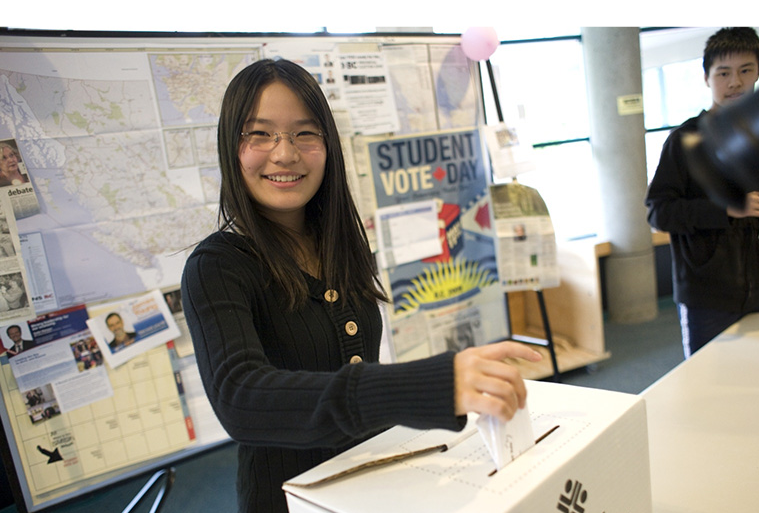
Democracy Bootcamp is a two-day professional development conference for elementary and high school teachers that is designed to improve teachers’ political interest and knowledge, increase their commitment to civic education, and increase their instructional capacity to teach students about democracy and citizenship. In February 2017, 166 teachers from throughout the province attended this event.
Looking forward, Elections BC plans to increase its in-house and public education capacity to focus on creating a strategy that supports civic education and long-term partnerships.
Election officials and office staff
District electoral officers, deputy district electoral officers and regional field officers
A district electoral officer (DEO) is appointed by the Chief Electoral Officer to conduct electoral events in their assigned electoral district. Assisted by one or more deputy district electoral officers (DDEOs), DEOs are responsible for hiring, scheduling and training election officials, overseeing voting and ballot counting and reporting results. By ensuring fair and impartial election administration in their electoral district, DEOs play a key role in the provincial electoral process.
87 DEOs and 90 DDEOs were appointed for the 2017 Provincial General Election. Due to the large geographical areas of the Peace River North and Powell River-Sunshine Coast electoral districts, two district electoral offices per district were needed to ensure accessibility. In these districts, a second DDEO was appointed to manage the additional office. A second DDEO was also appointed in Surrey-White Rock to provide additional support.
Elections BC delivered a series of training workshops to ensure that DEOs and DDEOs were prepared. Held in June 2016, September 2016 and February 2017, the workshops featured modular training sessions delivered in-person by Elections BC subject matter experts. A variety of educational strategies were employed, including visual presentations, practical exercises and numerous question-and-answer opportunities. DEOs and DDEOs were grouped into six regions, and each region attended training sessions together. The smaller region-based groups enabled DEOs and DDEOs to discuss common issues and challenges in electoral administration specific to their region.
Prior to each training workshop, DEOs and DDEOs completed online eLearning modules to prepare and make connections to related learning. DEOs and DDEOs were also provided laptops, smart phones, and access to the DEO Desktop website. This online resource was a “one stop shop” for DEOs and allowed Elections BC headquarters staff to provide support in real time. The paper DEO manual used in past elections was converted to digital format and made available on DEO Desktop. DEOs and DDEOs were able to securely access this information anywhere using a laptop or mobile device. This blended learning approach allowed DEOs and DDEOs to focus on applying content or practicing skills at the in-person training opportunities, and reinforced deeper learning over a longer period of time.
In 2013, the role of Regional Field Officer (RFO) was created as an additional level of support, providing a link between DEOs, DDEOs and Elections BC headquarters staff. In 2017, six RFOs, each with expert knowledge of their region and its unique challenges, offered mentoring, leadership, troubleshooting, quality enhancement and support during the election period. The RFOs also provided Elections BC with qualitative insight into the conduct of the election at the local level and helped Elections BC assess performance of DEOs and DDEOs.
District electoral offices and staff
A district electoral office was established in every electoral district in the province. In Peace River North and Powell River-Sunshine Coast, an additional office was opened to ensure accessibility for voters and candidates. All 89 offices opened to the public on April 10, closed to the public on May 10, and were vacated by May 31.
Recruitment for district electoral office staff began in November 2016 and continued through April 2017. DEOs hired 1,255 employees to provide administrative support, recruit and train election officials and conduct the election, including office managers, technical officers, trainers, recruitment officers and office support staff. Staff were trained in late March and early April before district electoral offices opened to the public on April 10.
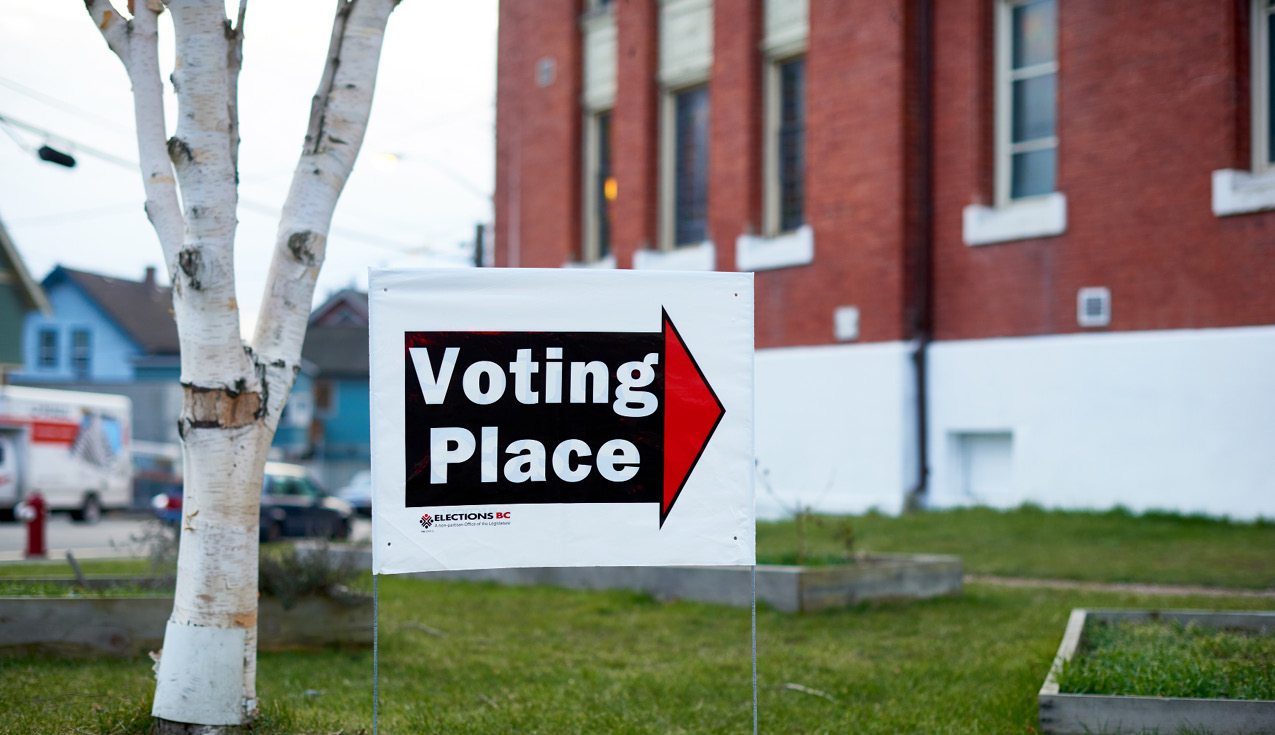
Election officials
Elections BC hired 23,369 election officials to serve voters in voting places. Election officials fill a variety of roles in the voting place, including:
- Voting officers, who are responsible for voting stations. Voting officers issue ballots and maintain a ballot box. At the close of voting, voting officers count ballots and are responsible for ballot reconciliation.
- Voting clerks, who assist voting officers. Voting clerks maintain the voting book at a voting station and, during counting, record the votes on a tally sheet.
- Information officers, who direct voters to the appropriate voting station at a voting place, provide information to voters and assist voters with disabilities.
- Supervisory voting officers, who supervise the officials at a voting place.
Election officials worked at 347 advance voting places, 1,317 general voting places, and as mobile teams that visited hospitals, long-term care facilities and other locations to ensure accessible voting opportunities for all eligible voters.
Election official training used a blended learning approach, similar to the training provided to DEOs and DDEOs. Election officials completed an online training course that provided background and context about the election and the election official’s role in the voting place. Online learning also prepared election officials for what to expect in the face-to-face classroom training that followed. Classroom training allowed election officials the opportunity to practice their assigned tasks and familiarize themselves with voting and reference materials in preparation for their role.
Youth at the Booth
A new initiative for the 2017 Provincial General Election, the Youth at the Booth program engaged youth in the electoral process by encouraging them to work as election officials. In collaboration with high schools across B.C., students between the ages of 15 and 19 were invited to apply as Youth at the Booth election officials. Youth at the Booth participants were hired as voting officers, voting clerks and information officers at voting places in their communities.

Over 200 high schools throughout B.C. registered for the program and more than 4,000 people under the age of 19 were hired as election officials, a 10% increase from the 2013 election.
The Youth at the Booth program encouraged a strong pool of qualified election officials with skill and comfort using technology, and promoted electoral participation and engagement to a new generation of voters. The program was popular with DEOs, school administrators and students who participated.
Number of election officials under 19 by provincial general election
|
General election |
Total number of election officials |
Number of election officials under age 19 |
Percentage of election officials under age 19 |
|
2005 |
29,531 |
2,106 |
7% |
|
2009 |
35,684 |
1,844 |
5% |
|
2013 |
33,106 |
2,924 |
9% |
|
2017 |
23,369 |
4,348 |
19% |
Headquarters staff
During a provincial general election, Elections BC’s Victoria headquarters grows from approximately 55 full-time staff members to over 150. Temporary staff include senior event support assistants (SESAs), contact centre supervisors and operators, electoral finance compliance officers, warehouse distribution assistants, voting book reviewers and nomination clerks.
The support from HQ was outstanding! In spite of what was likely an extremely busy and stressful period for them, all of the staff members that we dealt with were consistently pleasant, courteous and really helpful. For me, this was a highlight of the entire event. I really felt that I was part of a much bigger team.
— Patrick Maguire, DEO Nanaimo
Candidate nominations
To be nominated as a candidate for election as a Member of the Legislative Assembly (MLA), an individual must be qualified under the Constitution Act and the Election Act and file either a standing nomination or an ordinary nomination.
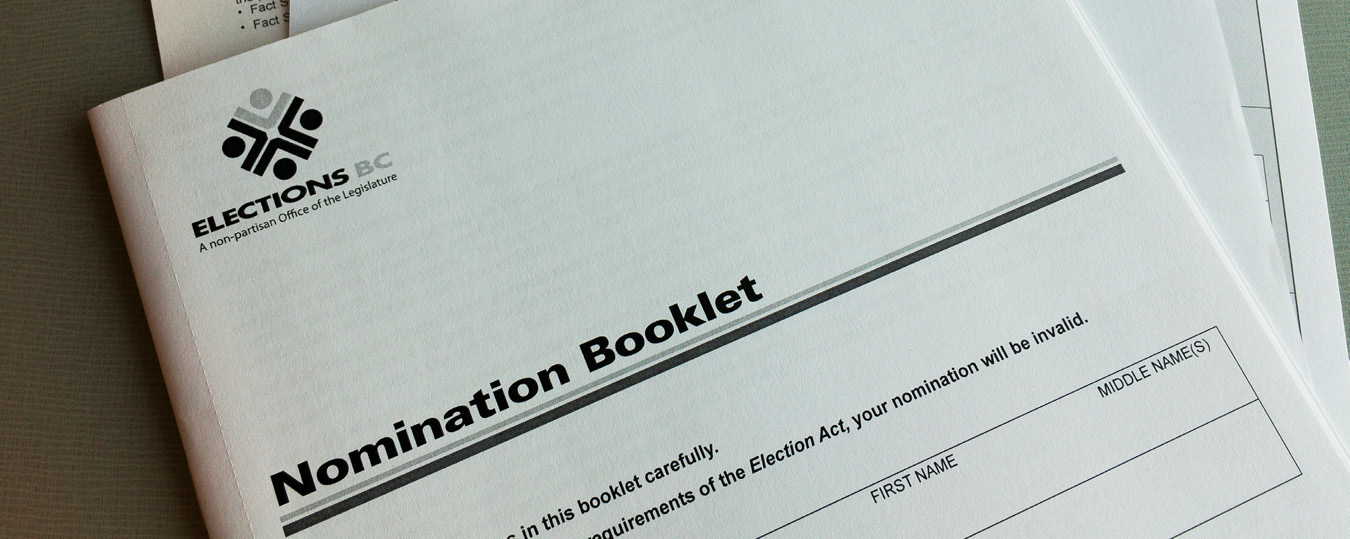
Elections BC accepts standing nominations for a fixed-date general election at any time until the end of the day before Writ Day. Ordinary nominations may only be filed between the time the election is called and 1 p.m. (Pacific time) on the seventh day after the election is called.
An individual becomes a candidate when their nomination has been accepted and a certificate of candidacy is issued. Certificates of candidacy for standing nominations are not issued until Writ Day.
The ordinary nomination period for the 2017 Provincial General Election closed at 1 p.m. (Pacific time) on April 18. There was a total of 371 candidates; 336 represented 18 registered political parties; 33 candidates ran as independents, and two candidates ran as neither independent nor as a representative of a registered political party. Two candidates withdrew their nominations. One individual submitted an ordinary nomination but withdrew before a certificate of candidacy was issued.
Number of candidates per party
|
Party ballot name |
Candidates |
|
4BC |
1 |
|
BC Action Party |
2 |
|
BC Cascadia Party |
2 |
|
BC Citizens First Party |
1 |
|
BC Conservative Party |
10 |
|
BC First |
1 |
|
BC Green Party |
83 |
|
BC Liberal Party |
87 |
|
BC NDP |
87 |
|
BC Refed |
3 |
|
BC Social Credit Party |
2 |
|
Christian Heritage Party of B.C. |
5 |
|
Communist Party of BC |
6 |
|
Land Air Water-The L.A.W. |
1 |
|
Libertarian |
30 |
|
Republican Party |
1 |
|
The Vancouver Island Party |
4 |
|
Your Political Party of BC (YPP) |
10 |
|
Unaffiliated |
|
|
Independent |
33 |
|
Other |
2 |
The number of candidates and registered political parties fielding candidates declined slightly from the 2013 Provincial General Election, in which 19 registered political parties were represented and 376 candidates were nominated, including 35 independent candidates and 11 with no affiliation.
The Election Act requires a political party to be deregistered after a general election if, for that general election and the immediately preceding general election, it was not represented by at least two candidates in one of the elections.
After the 2017 Provincial General Election one political party, People’s Front, was deregistered for failing to run sufficient candidates in either the 2013 or 2017 general elections.
Of the 371 candidates nominated for the 2017 Provincial General Election, 71% filed standing nominations, representing a 21% increase over the 2013 Provincial General Election.
Number of candidates, standing and ordinary nominations by provincial general election
|
Provincial general election |
Total candidates |
Standing nominations |
Ordinary nominations |
|
2005 |
412 |
243 (59%) |
169 (41%) |
|
2009 |
346 |
159 (46%) |
187 (54%) |
|
2013 |
376 |
187 (50%) |
189 (50%) |
|
2017 |
371 |
264 (71%) |
107 (29%) |
Of the 107 candidates who filed ordinary nominations, more than half filed in the last two days of the nomination period. The final day before the close of nominations saw the highest number of nominations filed. In the 2013 Provincial General Election approximately one third of ordinary nominations were filed in the final three days of the nomination period. The increase in the proportion of ordinary nominees filing close to the nomination deadline may be due to the relatively compressed nomination period, from 10 days in 2013 to 7 days in 2017.
Figure 3: Ordinary nominations by day
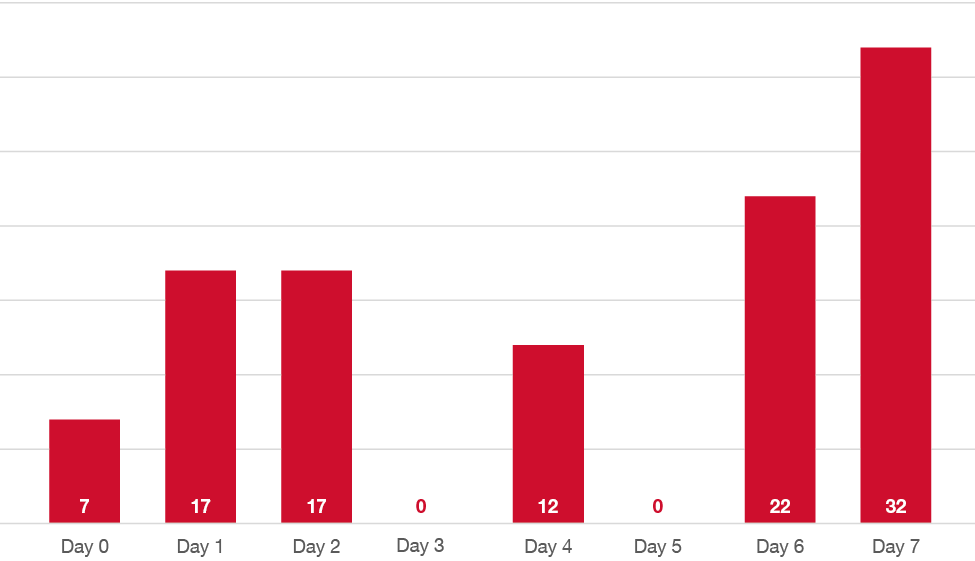
Although a large number of “last minute” filers can delay key activities including ballot printing and the production of statutory advertising, the final list of candidates was completed and distributed by Elections BC on April 19, the day following the close of ordinary nominations.
Elections BC hired two nomination clerks and one supervisor to receive and process nominations, and the nomination team maintained close communication with registered political parties, candidates and their agents throughout the process to answer questions and provide support.
Voting
British Columbia provides voters with more voting opportunities than any other jurisdiction in Canada. In addition to general and advance voting, the Election Act establishes numerous special and absentee voting opportunities, providing for an accessible and inclusive electoral process.
Elections BC conducted voting at 347 advance voting places and 1,317 general voting places. Special voting opportunities were also available in hospitals and long-term care facilities, on post-secondary campuses, and at select transportation hubs and other important sites throughout the province. Starting on Writ Day, all eligible voters could vote in any district electoral office or by mail. Voters with disabilities were offered the opportunity to vote by telephone for the first time in the 2017 Provincial General Election.
Advance voting
Advance voting was held from 8 a.m. to 8 p.m. (local time) on April 29 and 30 and May 3 to May 6. The six days of advance voting in 2017 reflect changes made to the Election Act in 2015 that increased the number of advance voting days from four in previous elections. Not all advance voting places were open on every day of the advance voting period, but at least one advance voting place was open in each electoral district on every advance voting day. Advance voting locations and the dates they were open were available on the Elections BC website in a variety of formats (including the Where to Vote application), advertised province-wide in community newspapers and printed on Where to Vote cards.
The proportion of voters who cast ballots at advance voting opportunities has steadily increased over the past six general elections, from 5.74% in 1996 to 30.17% in 2017.
Votes cast by voting opportunity
|
Voting opportunity |
Valid votes |
Rejected ballots |
% of ballots rejected |
Votes considered |
% of popular vote |
|
General voting |
1,202,942 |
4,433 |
0.37% |
1,207,375 |
60.78% |
|
Advance voting |
597,749 |
1,476 |
0.25% |
599,225 |
30.17% |
|
Special voting |
16,149 |
657 |
3.91% |
16,806 |
0.85% |
|
Absentee voting in electoral district |
67,252 |
474 |
0.70% |
67,726 |
3.41% |
|
Absentee voting out of electoral district |
35,782 |
3,140 |
8.07% |
38,922 |
1.96% |
|
Absentee advance voting |
17,098 |
852 |
4.75% |
17,950 |
0.90% |
|
Alternative absentee voting (in DEO office) |
31,365 |
488 |
1.53% |
31,853 |
1.60% |
|
Alternative absentee voting (by mail) |
6,375 |
142 |
2.18% |
6,517 |
0.33% |
|
Total votes considered |
1,974,712 |
11,662 |
0.59% |
1,986,374 |
100.00% |
Figure 4: Votes cast by voting opportunity

Figure 5: Advance votes, 1996-2017
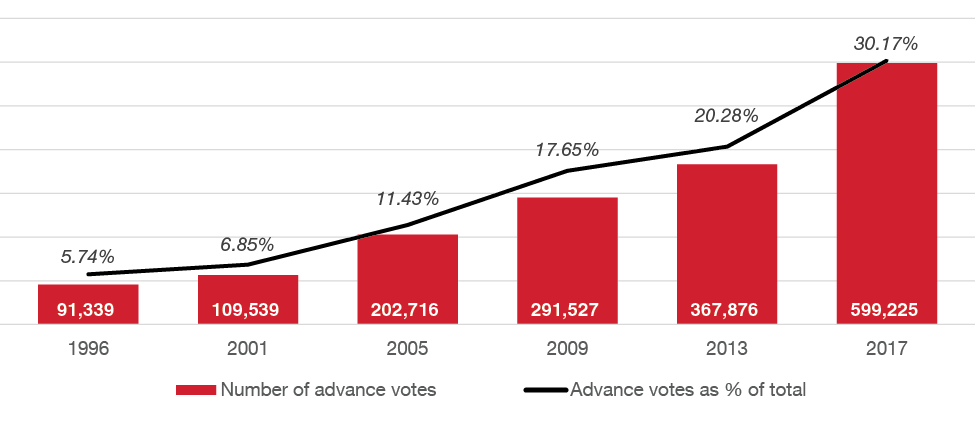
The large increase in advance voting turnout over the 2013 Provincial General Election is likely due to the increased number of days of advance voting in 2017, the fact that the two additional days were on a weekend, and the growing awareness and popularity of this voting option. For the past few general elections, Elections BC has also worked to increase public awareness of the many voting opportunities available to voters other than voting at their assigned voting place on General Voting Day. Advance voting places were listed on the Where to Vote cards mailed to all registered voters and residences without registered voters, and Elections BC offered more advance voting places (347) than in any previous general election. Advertising also emphasized advance voting opportunities. As in previous elections, the first and last days of the advance voting period were the most popular.
Figure 6: Advance voter turnout by day, 2017
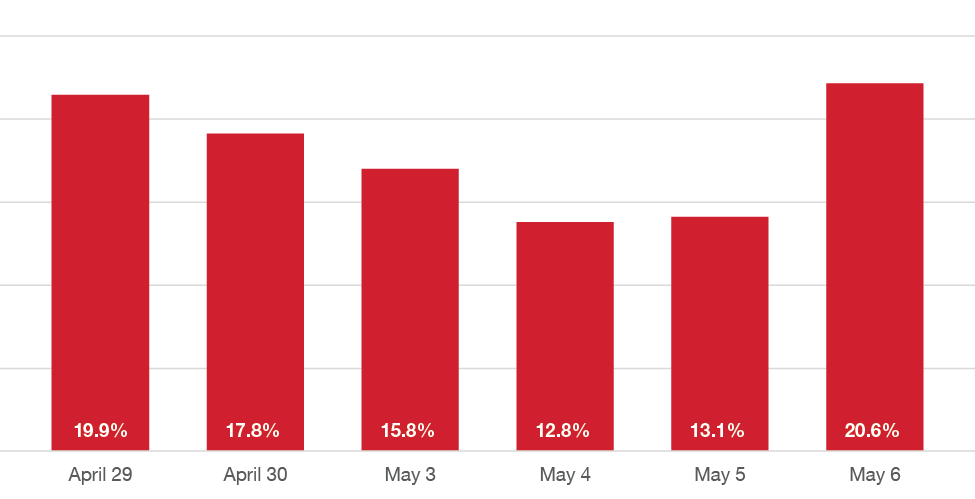
Special voting
A district electoral officer may establish special voting opportunities for voters in their district. Special voting opportunities are usually established for voters who are unable to vote at other opportunities because they will be absent or are in a hospital, mental health or care facility, provincial correctional centre, or remote community or work site. Special voting opportunities can be held at any point in the election period until the close of voting on General Voting Day.
In 2017, district electoral officers established special voting opportunities at sites throughout the province. Additional special voting opportunities were established at the University of Victoria, before the winter term was completed and students left campus for the summer, and at the Prince George Airport (YXS). As a major transportation hub for northern B.C., this voting place served voters flying in or out of Prince George, and airport staff.
16,806 voters cast their ballot at special voting opportunities during the 2017 Provincial General Election.
Absentee voting
Voters who voted at a voting place other than their assigned voting location on General Voting Day, or at an advance voting place outside of their electoral district, voted under absentee provisions. Absentee voting was available at all advance voting and general voting places. Voters who voted outside of their electoral district under absentee provisions used a write-in ballot to cast their vote for their electoral district of residence.
Voters were also able to vote in district electoral offices through alternative absentee voting. Voting in the district electoral office was available from when the election was called on April 11 until 4 p.m. (Pacific time) on General Voting Day. 124,598 absentee votes were cast at advance and general voting opportunities. 31,853 votes were cast in district electoral offices.
Vote by mail
B.C. voters can request a vote by mail package. The package must be returned to the district electoral office that issued it before the close of voting. The vote by mail option enables voters who may be away from B.C. for an extended period of time to vote.
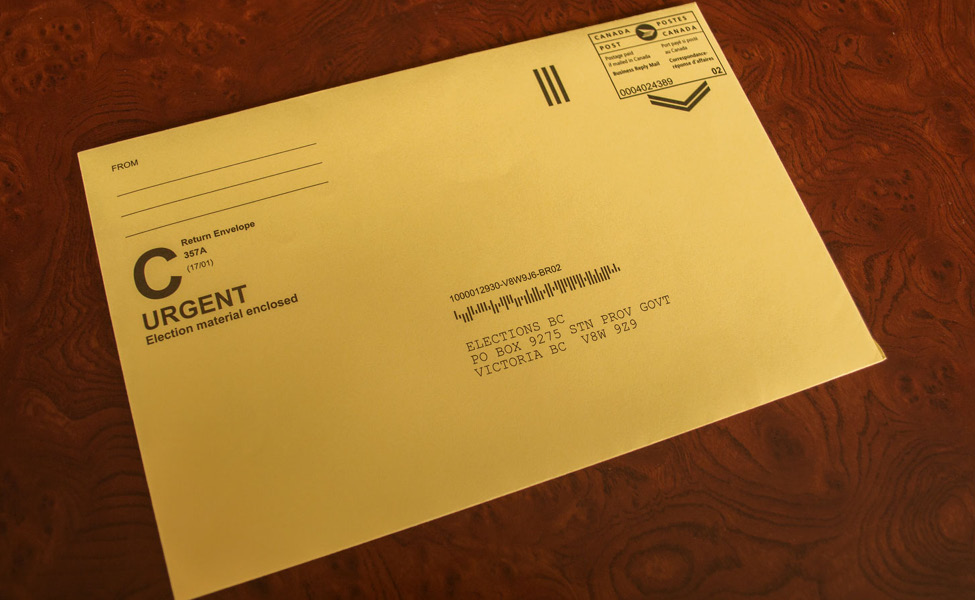
To address the length of time it takes to send and receive voting packages, particularly to remote areas and international destinations, Elections BC began sending voting packages to voters four weeks before the writs of election were issued. To meet the requirements of the Election Act, voters were instructed to not mark their ballot or return the voting package until after the writs were issued.
Elections BC sent voting packages to 59 countries and more than 10,000 voters. Every request for a vote by mail package was fulfilled. However, a significant number of voters who requested a voting package did not return it by the close of voting on General Voting Day. Some of these voters may have chosen to attend another voting opportunity instead; requesting a voting package does not mean a voter is marked as having voted. Since the majority of voting packages were sent to addresses in B.C., many voters who did not return their voting package were likely able to find another opportunity to cast their ballot in person.
Telephone voting
The telephone voting project piloted in the 2017 Provincial General Election allowed voters with disabilities that prevented them from voting independently at another voting opportunity to cast their ballot by phone. As part of its commitment to provide an accessible electoral process, Elections BC administered telephone voting through the contact centre. Election official-assisted telephone voting was available on weekdays from April 19 to May 8 from 12 p.m. to 6 p.m. On General Voting Day, telephone voting was available from 10 a.m. to 8 p.m.
Ensuring that voters who voted by telephone experienced the same right to privacy and secrecy as any other voter was an important consideration for Elections BC. The telephone voting process was developed to ensure the provisions of the Election Act would be met while also creating an accessible voting opportunity.
First, each caller’s identity and eligibility was confirmed. The call was then transferred to an election official who was not told the identity of the voter. The election official administered voting for the voter, including marking the ballot on their behalf. A second election official, who also did not know the voter’s identity, monitored the call and ensured the vote was cast according to the voter’s wishes.
Although telephone voting was available beginning on April 19, the highest number of voters wishing to vote by phone called on General Voting Day. As a result, a call-back queue was established. Several headquarters staff were affirmed as election officials in order to provide more resources. Any voters waiting to vote by phone as of 8 p.m. on General Voting Day were considered to be the equivalent of “in line” at a voting place, and as with any other voting opportunity, were entitled to cast their ballot.
The telephone voting pilot was well-received and provided another accessible voting opportunity for voters with disabilities. More than 1,000 voters cast their ballot through telephone voting.
General voting
General Voting Day was May 9, 2017. Voting was available from 8 a.m. to 8 p.m. (Pacific time) at 1,317 general voting places across the province. Voters were assigned a general voting place according to the voting area in which they resided. However, as part of B.C.’s accessible electoral process, all eligible voters could vote at any voting place in the province under absentee voting rules. 60.78% of ballots were cast on General Voting Day by voters at their assigned general voting place.
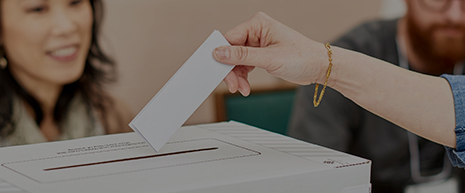
Turnout
Voter turnout in the 2017 Provincial General Election increased both as a percentage of eligible voters and as the total number of ballots cast, continuing an upward trend in voter turnout since the 2009 Provincial General Election.
Figure 7: Voter participation, 1983-2017
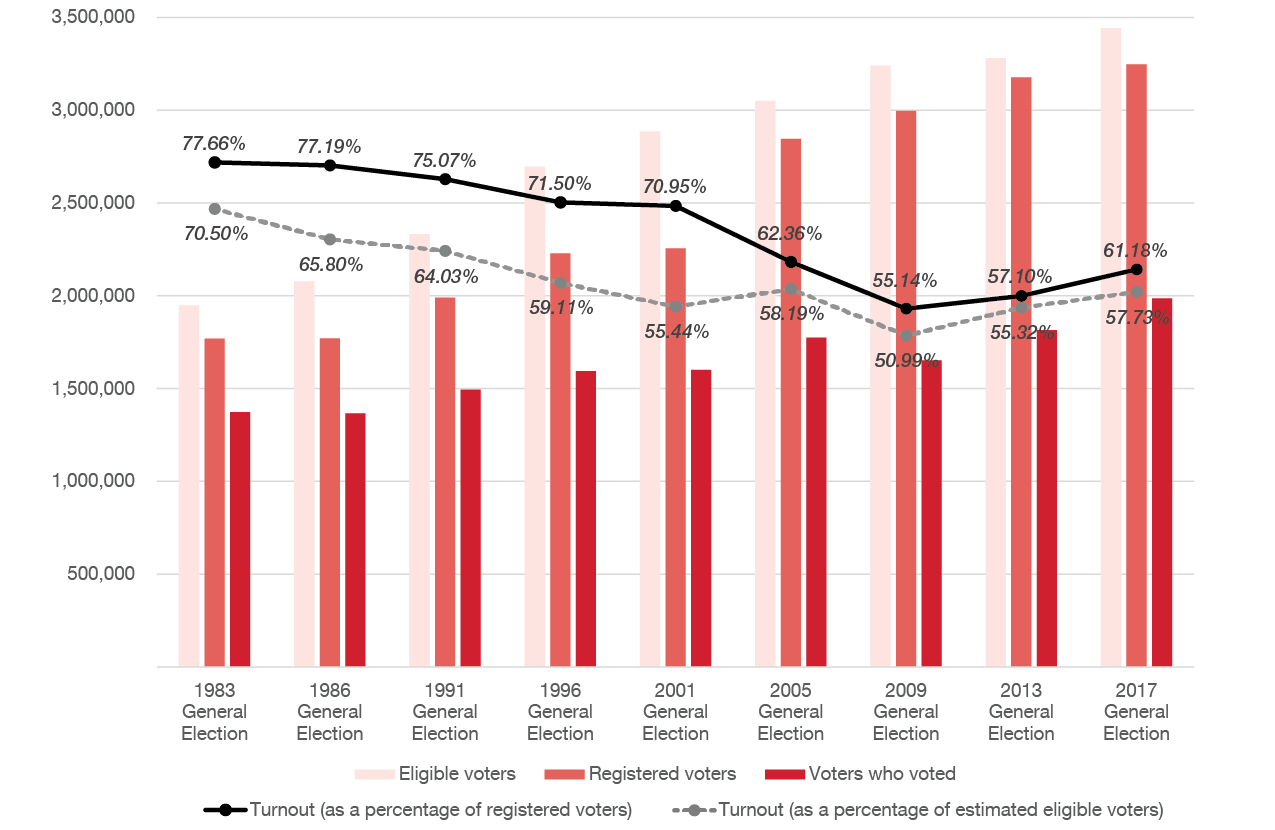
The increase in turnout from 55.32% of estimated eligible voters in 2013 to 57.73% of estimated eligible voters in 2017 represents 170,000 more British Columbians who cast ballots in the 2017 Provincial General Election. The increase in turnout was reflected across all age groups.
Voter participation by age group, 2017 Provincial General Election
|
Group |
18-24 |
25-34 |
35-44 |
45-54 |
55-64 |
65-74 |
75+ |
Total |
|
Registered voters |
221,732 | 515,675 | 501,745 | 581,234 | 625,310 | 464,574 | 336,377 | 3,246,647 |
|
Registered voters who voted |
124,707 | 239,008 | 277,379 | 347,836 | 421,190 | 348,659 | 227,595 | 1,986,374 |
|
% of registered voters who voted |
56.24% | 46.35% | 55.28% | 59.84% | 67.36% | 75.05% | 67.66% | 61.18% |
Trends
The 2017 Provincial General Election saw a continued shift in voting habits away from voting on General Voting Day at an assigned general voting place. More voters than ever before voted at advance, absentee and special voting opportunities.
Figure 8: Trends in the use of voting opportunities, 2005-2017
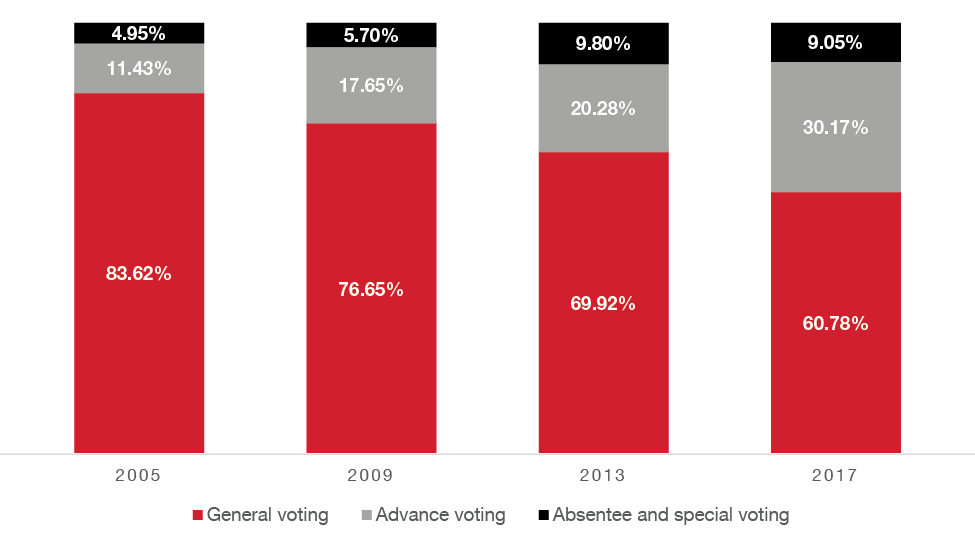
Recognizing these trends, Elections BC anticipated increased participation at advance voting, voting in district electoral offices, and voting by mail. Elections BC prepared for a potential 30% voter turnout at advance voting. This figure was very close to the actual advance turnout rate of 30.17%.
At district electoral offices, absentee voting decreased slightly, from 1.96% in 2013 to 1.60% in 2017. The use of vote by mail packages also decreased by a small amount (from 0.37% in 2013 to 0.33% in 2017). The small decrease in these forms of absentee voting may be due to the extra days of advance voting providing more opportunities to voters who would otherwise have voted in the district electoral office or by mail.
Counting
Initial count
Ordinary ballots from advance voting and general voting are counted at initial count, conducted following the close of voting on General Voting Day. In the 2017 Provincial General Election, approximately 90% of the total ballots cast were considered at initial count.
At the close of initial count on election night, the BC Liberal Party led in 43 electoral districts, the BC NDP in 41, and the Green Party of BC in three.
Recounts
Under the Election Act, candidates or their official agents can request a recount of some or all of the ballots considered at initial count within three days after General Voting Day. Recount requests can only be made where:
- the difference between the top two candidates is close (defined in the Election Act as 100 votes or fewer); or
- votes were not correctly accepted or ballots were not correctly rejected, or a ballot account does not accurately record the number of votes for a candidate.
In 2017, six recount requests were received for five electoral districts.
Recounts in the 2017 Provincial General Election
|
Electoral district |
Candidate who made the request |
Recount request accepted? |
|
Coquitlam-Burke Mountain |
Jodie Wickens |
No |
|
Courtenay-Comox |
Jim Benninger |
Yes |
|
Maple Ridge-Mission |
Marc Dalton |
No |
|
Richmond-Queensborough |
Aman Singh |
No |
|
Vancouver-False Creek |
Morgane Oger |
No |
|
Vancouver-False Creek |
Philip James Ryan |
Yes |
Four of these requests did not meet the criteria above, and were not approved.
Recount requests were approved and recounts were conducted in two electoral districts, Courtenay-Comox and Vancouver-False Creek.
In Courtenay-Comox, the recount request was accepted because the difference between the top two candidates was nine votes. The recount was completed on May 22, 2017 and the margin between the top two candidates increased to 13 votes.
A recount request for Vancouver-False Creek was accepted because of a discrepancy between the advance voting ballot account for one candidate and the tally sheet and parcel envelope containing ballots for that candidate. The recount was completed on May 22, 2017 and the number of valid votes for two candidates decreased slightly. The results from initial count were confirmed.
A voter, candidate or district electoral officer for the electoral district may also make an application to the Supreme Court of British Columbia for a judicial recount. The application must be made within six days of the declaration of official results at the conclusion of final count. No judicial recounts were requested in the 2017 Provincial General Election.
Final count
Final count is a count of the ballots that were not considered as part of initial count. Ballots considered at final count include those cast at absentee, alternative absentee and special voting opportunities. The results of the election are determined at the conclusion of final count, based on the votes accepted at initial count and final count. Final count begins 13 days after General Voting Day, to allow enough time for absentee ballots contained in certification envelopes to be sent from where they were cast to the voter’s district of residence. Final count in each electoral district is held in the district electoral office and may continue for up to three days.
Final count for the 2017 Provincial General Election began on May 22 and concluded on May 24. At the conclusion of final count, the seat count between the top three parties was unchanged from the results reported at initial count. The writs of election were returned on May 31, 2017, marking the end of the election period for the 41st Provincial General Election.
Summary of results by affiliation, 2017 Provincial General Election
|
Affiliation |
Abbreviation |
Total valid votes |
% of total valid votes |
Candidates elected |
|
BC Conservative Party |
CP |
10,421 |
0.53% |
0 |
|
BC Green Party |
GP |
332,331 |
16.83% |
3 |
|
BC Liberal Party |
LIB |
797,194 |
40.37% |
43 |
|
BC NDP |
NDP |
795,527 |
40.29% |
41 |
|
Christian Heritage Party of B.C. |
CHP |
3,398 |
0.17% |
0 |
|
Libertarian |
LBN |
7,743 |
0.39% |
0 |
|
Independent |
IND |
20,971 |
1.06% |
0 |
|
Other* |
- |
7,127 |
0.36% |
0 |
|
Total |
1,974,712 |
100.00% |
87 |
* 4BC (FBC), BC Action Party (BCAP), BC Cascadia Party (BCC), BC Citizens First Party (CFP), BC First (FP), BC Refed (REFD), BC Social Credit Party (SC), Communist Party of BC (COMM), Land Air Water-The L.A.W. (LAW), Republican Party (NRP), The Vancouver Island Party (VIBC), Your Political Party of BC (YPBC)
Notable events
Flooding in the Okanagan
In planning and administering a general election, Elections BC tries to account for all possibilities. Early in the planning process, risks, the probability that they will occur and their potential impact are identified and contingencies are put in place in the event that they do occur. Elections BC’s risk management framework was put to the test during the 2017 Provincial General Election when severe flooding impacted several areas of the province.
Flooding in the Okanagan region began on May 5, continuing through the second advance voting period and the days leading up to General Voting Day. Some areas of the Kelowna-Lake Country, Boundary-Similkameen, Shuswap and Fraser Nicola electoral districts were evacuated due to flood waters and landslides or put on evacuation notice. Elections BC monitored the situation closely and took measures to ensure that all affected voters were able to cast their ballots.
- In Kelowna-Lake Country, the general voting place at Holiday Park Resort was not available due to flooding. Voters assigned to this general voting place were reassigned to the nearby general voting place at Winfield Memorial Hall.
- In Boundary-Similkameen, the general voting place at the Grand Forks Sr Hall was not available due to flooding. Voters assigned to this general voting place were reassigned to the nearby general voting place at Sacred Heart Catholic Church.
- In Shuswap, a landslide forced the closure of Sunnybrae Canoe Point Road at Robinson Creek. Evacuated residents were directed to vote at their nearest voting opportunity. A mobile team of election officials were deployed via water taxi to the area northeast of the closure to administer special voting door-to-door on General Voting Day.
- In Fraser-Nicola, Highways 8 and 97D were closed in both directions. The District Electoral Officer directed voters to other voting places accessible from their location.
The possibility of a natural disaster occurring and impacting voting places was identified as a risk during the process of planning the 2017 Provincial General Election. DEOs were well prepared and managed to make alternative voting arrangements on short notice.
Focus on final count
At the close of initial count on election night, the preliminary voting results showed a slim margin between the two leading political parties, both in seat count and in the popular vote. The BC Liberal Party led in 43 electoral districts, the BC NDP in 41 and the Green Party of BC in three. No party had reached the threshold of 44 or more seats needed to form a majority government. In four districts, the results of initial count showed a margin of 300 or fewer votes between the top two candidates.
Electoral districts with margin of 300 or fewer votes between top two candidates
after initial count
|
Electoral district |
Difference between top two |
|
Coquitlam-Burke Mountain |
170 |
|
Courtenay-Comox |
9 |
|
Maple Ridge-Mission |
120 |
|
Richmond-Queensborough |
263 |
On election night, Elections BC reported preliminary election results in each electoral district as ballots were counted. However, preliminary results do not include absentee ballots. Due to the close preliminary results, the outcome of the election could not be assumed until the conclusion of final count. This led to an unprecedented degree of public and media attention on the proceedings of district electoral officer recounts and final count.
In the two weeks between initial count and final count, Elections BC recognized its responsibility to provide accurate up-to-date information to the public as speculation about the election results grew. Through news releases, media interviews and social media, Elections BC provided the public with updates about the number of certification envelopes containing ballots to be counted at final count, both province-wide and by electoral district, as well as the status of district electoral officer recount requests.
As district electoral officer recounts and final count began on May 22, Elections BC made updated results available online at 10 a.m., noon, 2 p.m. and 5 p.m., or more frequently as counts in each electoral district were completed. On the afternoon of May 24, Courtenay-Comox was the last electoral district to complete counting and report its final results.
A topic of particular scrutiny during this period was the 13-day period between initial count and final count established under the Election Act. Under the current voting model, this period is needed to give DEOs enough time to ship certification envelopes containing absentee ballots to the voter’s electoral district of residence, and receive and screen certification envelopes from other districts in preparation for final count. Elections BC is working on a proposal for a new voting model for future provincial general elections, and is considering ways in which the period between initial count and final count could be reduced or eliminated.
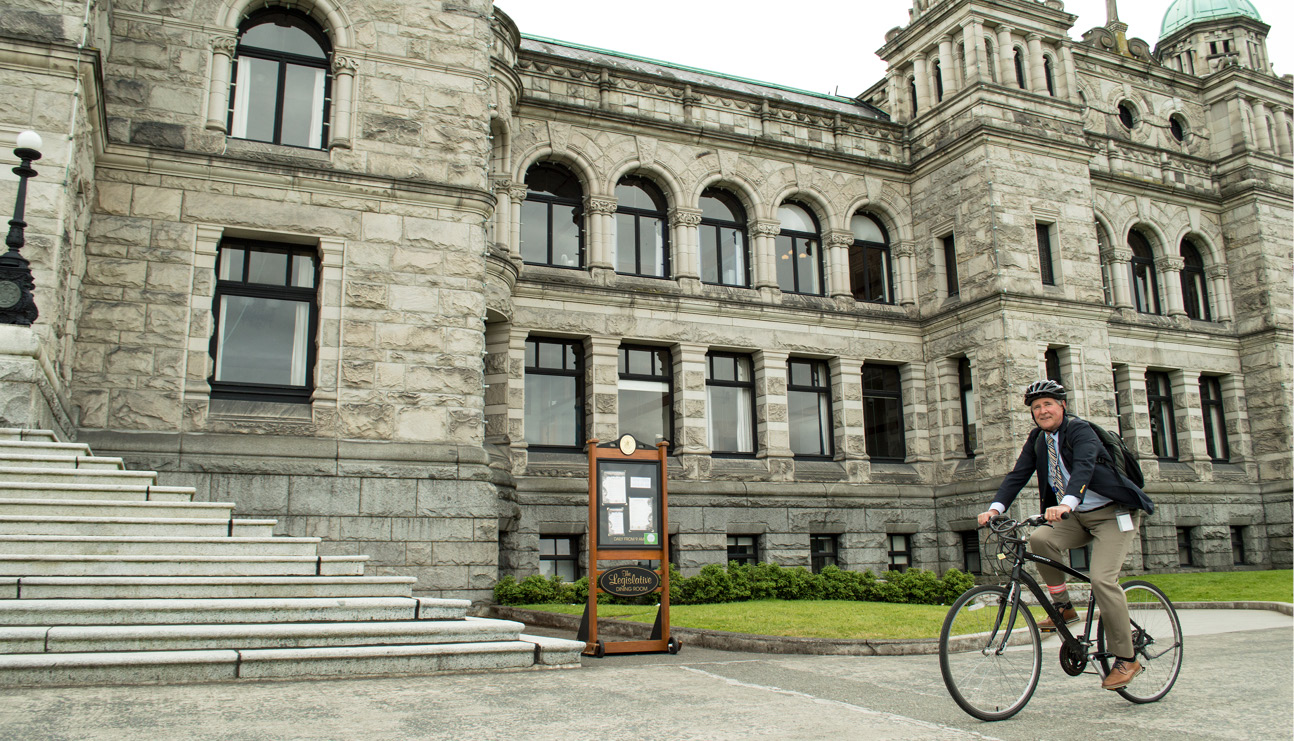
Orders
For the vast majority of voters, voting in the 2017 Provincial General Election proceeded without incident. In some instances, however, errors made by voters or election officials prompted the Chief Electoral Officer to issue an Order. Established by section 280 of the Election Act, an Order permits the Chief Electoral Officer to make exceptions to the Act if necessary because of an emergency, mistake or extraordinary circumstance. The Chief Electoral Officer issued 51 Orders related to the 2017 Provincial General Election. The majority of Orders were the result of election official errors, evidence of the complexity of provincial electoral legislation and the need to continue to review election official procedures with a view to simplifying processes. Summaries of the Orders are provided below.

